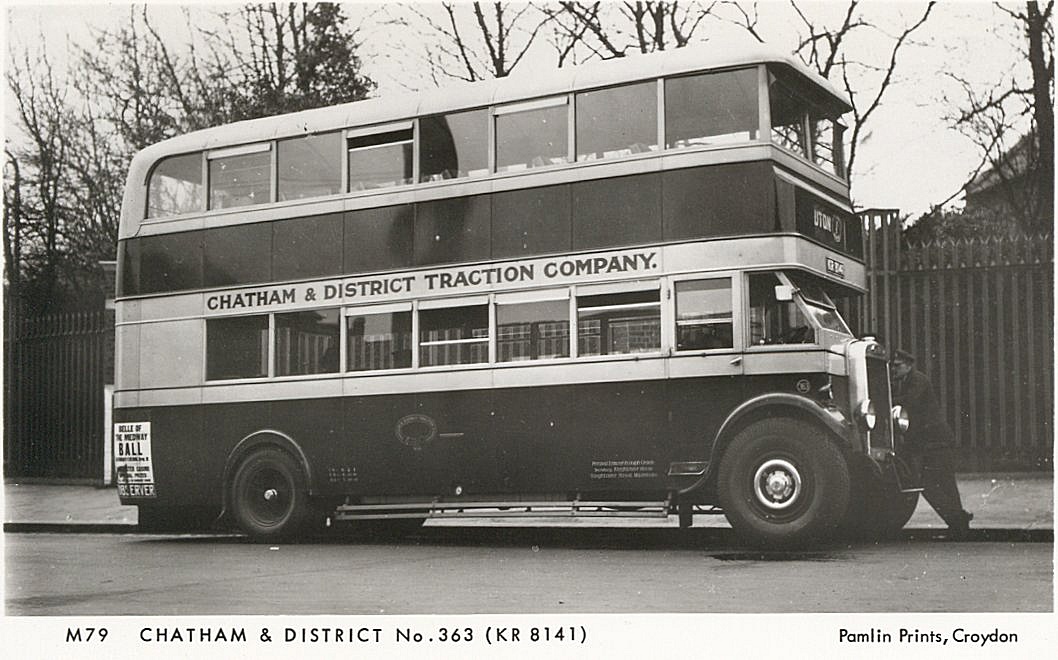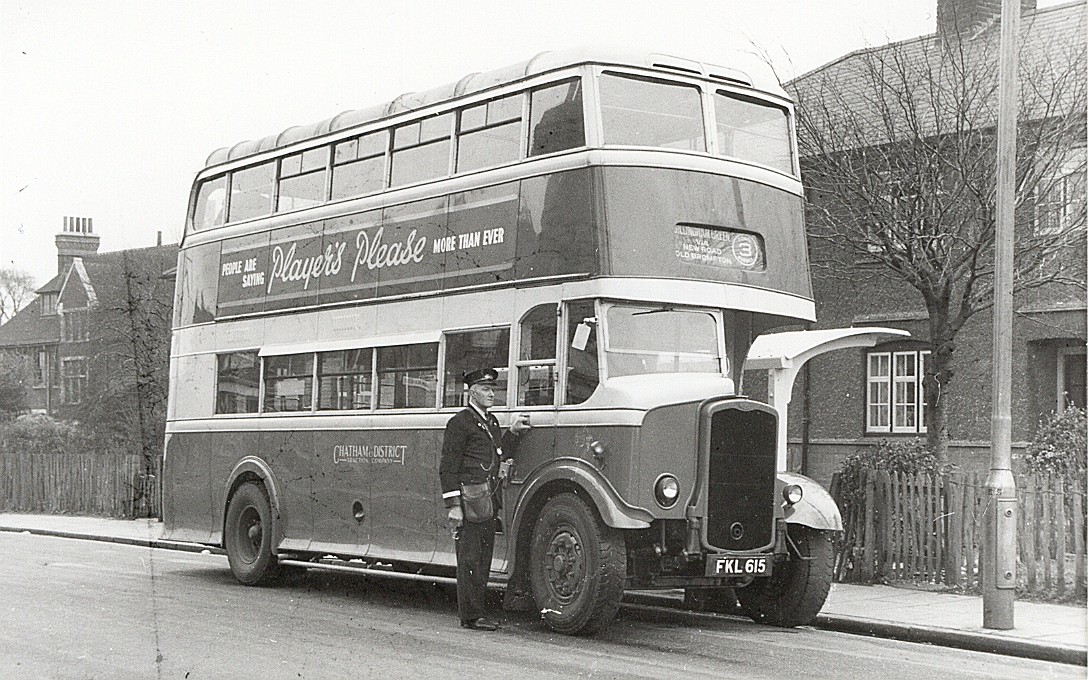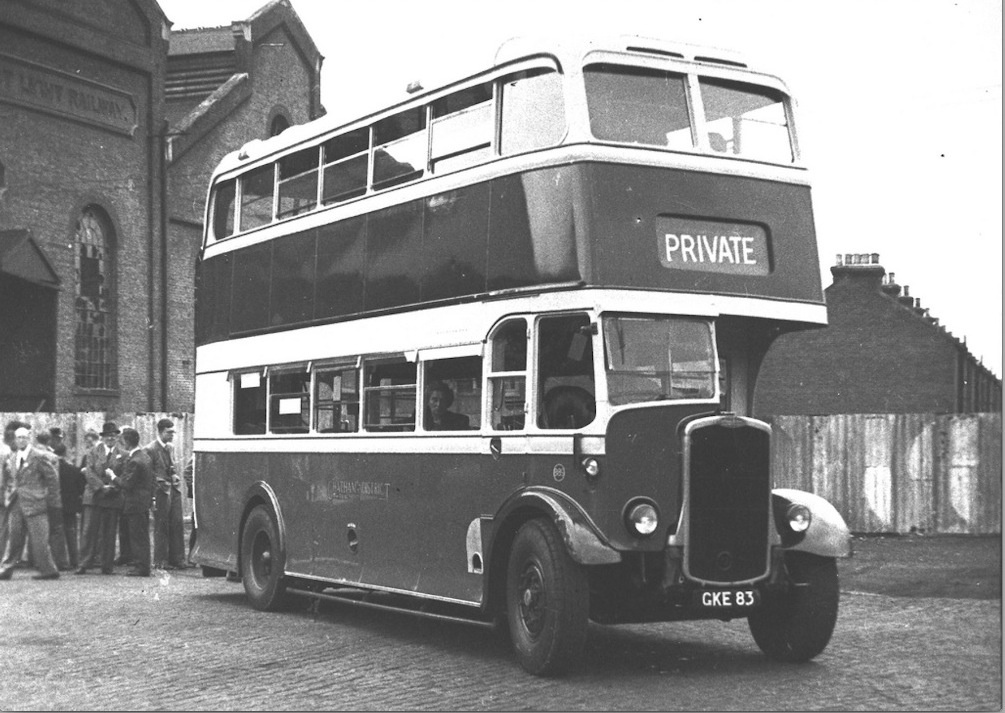Chatham Traction Routes
The start of Chatham & District's bus services on Wednesday 1st October 1930 saw a brand new fleet of Leyland Titan TD1s enter service on the former tram routes. However this network was re-arranged and simplified, with the services numbered for the first time, as follows:
- Luton (Hen & Chickens) and Dockyard (Pembroke Gate)
- Chatham Cemetery and Rainham
- Frindsbury and Gillingham Green
- Strood Hill and Town Hall
- Borstal and Gillingham Strand
The result was a more uniform pattern of services and a greater choice of through journeys. In conformity with the 1929 Act of Parliament the streets and roads used by the new routes did not depart from those used by the trams.
Some of the service termination points had to be adjusted to take account of the need to physically turn a bus, something not necessary with the trams. The Rainham terminus of what was now service 2 was moved down Station Road to Webster Road, although it’s not clear what was done at the other end - turning a bus at Chatham Cemetery where the side roads went very steeply downhill would have been an interesting exercise. Service 3 was extended beyond the Grange Road junction to Gillingham Green itself. At Borstal the service 5 buses went beyond the end of the tramlines at Manor Lane to turn at Silver Hill, whilst at the Gillingham end a regular service went beyond the Shalders Arms along Pier Road to the Strand at last. What joy this must have brought, to be able to reach Medway’s little Riviera with such convenience!
The first route changes occurred in 1933. The no.2 was extended up Maidstone Road from the Cemetery to Huntsman’s Corner, and service 4 was taken from Strood Hill up to Rede Court. A new service designated 3A paralleled the no.3 from the Town Hall through Rochester and Strood, but took off up Cliffe Road as far as Slatin Road.
The Towns continued to expand, causing people to travel farther to work. Recognising the need to serve a wider geographical area there were more route changes in 1937. The Wagon-at-Hale became the Luton end destination of service 1. Service 4 became a circular at the Strood end, running from Strood Hill to both Rede Court and Salter’s Cross via Rede Court Road, alternate workings running in opposite directions round the loop, a vulnerable arrangement!
Routes continued to extend ever outwards. In January 1939 applications were made for new routes along Cliffe Road from Slatin Road to Brompton Farm Road for the 3A, and from Huntsman’s Corner to Magpie Hall Road Top for service 2. These extensions not only served the expanding development, but took account of increasing road vehicle traffic by moving turn-round points to more convenient locations.
As a wartime economy measure Wagon-at-Hale journeys on service 1 were withdrawn in 1940, the terminus reverting to the Hen & Chicks.
Service alterations in 1942 saw service 4 extended from the Town Hall to Gillingham Green, and new service 5A, running as service 5 from the Strand to Priestfields (Rochester), then to Cookham Wood, Sir Evelyn Road, via Maidstone Road.
An extension to the no.1 route in 1945 responded to the expanding housing beyond Luton village. Journeys beyond the Hen & Chicks to the Wagon-at-Hale were re-instated, but now alternated with others to the new Wayfields estate at Churchill Avenue.
The vulnerability of the routing of service 4 at the Strood end finally exhausted the locals’ patience in April 1947, and improvements were demanded through letters to the press. It was alleged that Chatham Town Hall departures although regulated by the Town Hall clock were often missed because the clock was rarely in agreement with Greenwich Time! The arrangement where alternate buses did the trip in reverse “seemed to be subject to the whims of the drivers”. This referred to the practice whereby the London Road – Rede Court Road – Gravesend Road loop was scheduled to be traversed in opposite directions by successive workings. It was suggested that services 3a and 4 were combined – each to run round the circle in opposite directions. Change did come, but not quite as suggested, and not for a few years.
In 1949 services to Luton altered yet again. The no.1 now ascended Wayfield Road to terminate at Mountbatten Avenue, whilst its alternate trips to Wagon-at-Hale were withdrawn once more. Instead, Brompton Farm Road service 3A was extended from the Town Hall to the Wagon. The changes weren’t over yet, however, for in 1952 the no.1 finally reached Burma Way. Also in 1952 the long awaited change to service 4 arrived, although perhaps not as the protesters had asked. The Rede Court Road loop was abandoned, the service now using only Salter’s Cross as its terminus. At the other end, the service now ran to Luton instead of Gillingham Green, alternate workings terminating at the Wagon-at-Hale and Churchill Avenue. The 3A now ran to Gillingham Green, replacing the service 4 to that terminus.
In 1955 service 2 gained a long extension from Magpie Hall Road to the new Weeds Wood Estate, negotiating the daunting Waterworks Hill in the process. This was the last change in the service routes for the brown buses.
Below are Chatham Traction routes and termini as at 1955 shown against 2004 map.
Key:
A - Former Rede Court terminus.
B - Rochester High St./ Corporation St. one-way system.
C - Star Hill
D - Chatham Town Hall / Military Road
E - Luton Arch / Chatham Hill
F - Churchill Avenue (alternate terminus of service 4)
G - Luton Depot/Hen & Chickens
H - Jezreels
J - Former reserved tram track.
(Reproduced from the Ordnance Survey Mapping with the permission of the Controller of Her Majesty's Stationery Office. ©Crown Copyright. Medway Council Licence No. 100024225 2004.)
Buses
The composition of Chatham Traction’s fleet of buses can be divided into four eras, reflecting the requirements of providing the service, the technical advances in bus design and manufacture and the prevailing circumstances at different periods during the company’s existence. Whilst each of these four eras represent the acquisition of significant batches of distinct vehicle types, small numbers of other vehicles from time to time formed part of the Chatham fleet, usually through background arrangements with the parent Maidstone and District company.
Bus manufacture in the 1930s was a diverse industry. Bus operators would buy chassis and body separately, often from different specialist suppliers, with strong doses of preference or special requirements seen as essential to their particular circumstances. This general principle prevailed throughout the life of Chatham Traction although rationalisation and standardisation began to take hold during the post-war period.
Full details of the individual vehicles that at various times formed part of the fleet – delivery and disposal information, chassis and body numbers, etc. – have been meticulously recorded by the M&D and East Kent Bus Club. This information is available in their various publications as listed on the Club’s website. A special booklet listing all Chatham Traction’s vehicles was produced for the 2005 Commemorative Event.
The Titans
From the start of bus operation in 1930, Chatham Traction services were operated by 48-seat Leyland “Titan” TD1 vehicles. The Lancashire based company supplied both chassis and body, and were popular with operators throughout the country. The local press were enthralled. “Of a colour scheme of brown (on top), green (below), with an upper and lower saloon, both enclosed and accommodating 24 passengers the majestic looking automobile symbolises luxuriant travel” opined the Chatham, Rochester and Gillingham News.
A total of 43 TD1s were supplied, in batches, during 1930-31. Their entry into service wasn’t without its initial difficulties. Chassis fractures began to appear, requiring some urgent work by the manufacturer. The influence of the M&D interest was evident from the outset, as a few M&D vehicles were loaned to Chatham Traction to make up the 37 buses needed for the start-up of services whilst the delivery of new vehicles was completed and the chassis problems were addressed.
The origin of the distinctive Chatham Traction livery is not totally clear. Histories of the tram system suggest that the trams had been painted “light grass green and cream”, which would explain the buses’ lower deck paint scheme. However the origin of the “ginger brown” as the upper deck colour is not known. Early 20th century tram operators often painted their vehicles’ running gear “a dark reddish brown”, probably as a means of reducing the effect of the inevitable discolouration from cast-iron brake dust, and use of this colour is a possibility.
One of the 1931 Titans at Pembroke Gate
In the early years the buses carried the full fleet name on the cream panel above the lower deck windows, supplemented by a garter belt device on the lower body panels of a very similar style to that carried by the trams.
Destinations were shown by a single roller blind display at the front and rear, sometimes including a single “via” point. Route numbers were included on the right of the display, the number being contained in a circle and within the words “Town Service”, these words being arranged circumferentially. This was to distinguish the Chatham Traction routes from those of M&D (although the more obvious distinction was that the display adorned a “brahn bus”!).
The Early Bristols
The TD1s lasted through most of the 1930s, but it was evident by 1937 that something else was needed. “Big Brother” M&D had also purchased Titans but the mid-1930s saw the beginning of a long association with the Bristol Tramways and Carriage Company through the purchase of new bus chassis of the “Bristol” marque. Four Bristol GO5G chassis with contemporary 54-seat bodies by Weymann (of Addlestone, Surrey) arrived at Luton depot in 1937, part of an order for a larger quantity placed by M&D. The “G”-type chassis was quickly found to be unsatisfactory, however, and in the following year the unusual step was taken of transferring the existing bodies on to new Bristol K5G chassis. (The K5G designation stood for K-type, 5-cylinder, Gardner engine.)
One of the 1937/38 Bristols at Frindsbury
The “K”-type proved a much better buy and in 1939 a delivery of 37 K5Gs with updated Weymann bodies was received. This Bristol/Weymann combination became a M&D hallmark through the 1940s and early 50s and was rare outside their operating area. Buses of this type lasted until the end of Chatham Traction’s separate existence and were its typical public face.
1939 Bristol GKE 83 at Luton depot.
The 1942 Bristols
Bristol K5G chassis continued to be supplied to M&D through the war years, but in line with government policy of the times they carried bodies built to a standard Utility design by a number of manufacturers. This design included mostly flat panels, with only simple curves allowed where necessary, whilst for seats upholstery gave way to slatted wood. Chatham Traction eventually received eleven altogether of these vehicles, with bodies from Park Royal, Bristol and Strachans.
A 1942 Bristol with a utility Bristol body.
The utility bodies were never intended to last long, and Chatham Traction’s utility Bristols received new bodies to an updated Weymann design in the early 1950s.
The style of the company fleet name had changed during the 1940s. Another change was to show the route number on separate three-track number blinds, providing more room for the destination display in the standard sized aperture.
A 1942 Bristol as re-bodied in 1951.
The Guy Arabs
Changes in the bus industry in the early 1950s meant that supplies of Bristol chassis were no longer available to operators outside the Tilling group of companies. Whilst M&D instead bought Leyland’s PD2 chassis, Chatham Traction turned to Guy Motors of Wolverhampton. This was perhaps because of a wish to continue with engines supplied by the Gardner company of Manchester. Gardner’s 5LW engines had successfully powered C&D’s Bristol buses, but the new Guys had the more powerful 6LW unit with the addition of exhaust brakes, perhaps an ideal arrangement for the hilly Medway routes.
Taking advantage of the newly-relaxed maximum body dimensions the “8-foot Guys” were purchased in three batches of 8 buses to replace the early Bristols. Carrying MCW “Orion” bodies, the first batch arrived in late 1953, the second a year later. The third batch was delivered at the end of 1955, after absorption of C&D by M&D.
One of the first batch of Guy Arabs, delivered in November 1953.







